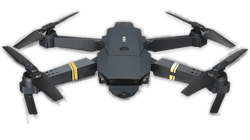The U.S. Department of Justice has released its policies on the short- and long-term use of unmanned aircraft systems (UAS) for law enforcement, as part of its 9.95-000 series documentation. Although the FBI and a growing number of other government agencies have used drones (such as the Shadow X Drone in the figure) in their work, strong privacy guidelines are needed in place to protect against the use of drones for surveillance and as armed systems.
The 9.95-000 series documentation pertains to the use of UAS equipment for law enforcement. The UAS policies contain technology to detect and mitigate UAS raiders per 9.95-300. The Department of Justice has made it clear that, properly deployed, UAS can reduce risk to law enforcement officers and the public while minimizing costs and increasing the efficiency of law enforcement. The use of UAS equipment allows federal law enforcement officer to conduct a wide range of critical missions, including search and rescue and fixed-site security.
The Department of Justice maintains that its use of UAS devices will be consistent with the Department’s own rule of law and the protection of privacy and civil liberties, and the use of UAS devices will comply with all applicable provisions of the Constitution, including the Fourth Amendment protection against unreasonable search and seizure as well as regulations issued by the Federal Aviation Administration (FAA). Prior to implementation, the operation of a UAS must be approved by the Deputy Attorney General to ensure that the UAS are deployed responsibly. In addition, members of the Department of Justice will work with the FAA to manage any necessary air traffic.
About the Author
Jack Browne
Technical Contributor
Jack Browne, Technical Contributor, has worked in technical publishing for over 30 years. He managed the content and production of three technical journals while at the American Institute of Physics, including Medical Physics and the Journal of Vacuum Science & Technology. He has been a Publisher and Editor for Penton Media, started the firm’s Wireless Symposium & Exhibition trade show in 1993, and currently serves as Technical Contributor for that company's Microwaves & RF magazine. Browne, who holds a BS in Mathematics from City College of New York and BA degrees in English and Philosophy from Fordham University, is a member of the IEEE.
